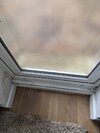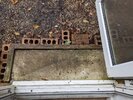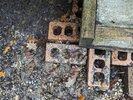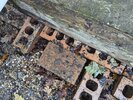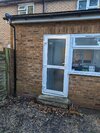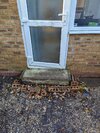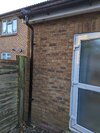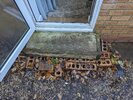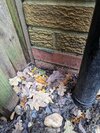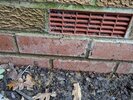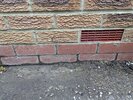I noticed a couple of small patches of damp around the rear uPVC door in the extension leading to the garden. Additionally the extension is very cold with the floor in particular being cold. The step outside the door is built on a foundation of bricks that are exposed and the gutter above the step has been overflowing with water coming down onto the concrete step and bricks. I have fixed the issue with the gutter so no more overflow during the rain. I would like some advice on what to do next, I guess I should have the bricks removed and replaced with a more appropriate base with a damp proof membrane. I'm hoping this will fix the damp issue and also improve the temperature in the room. Any advice gratefully received.

You are using an out of date browser. It may not display this or other websites correctly.
You should upgrade or use an alternative browser.
You should upgrade or use an alternative browser.
Damp around rear uPVC garden door
- Thread starter rafiq_h
- Start date
Stand back and take wider pics of the wall, all the way up to the roof and gutters. Show all downpipes, gullies and drains, and the doorframe, including sides and top. Where is the DPC on your house?
Pour some water on the paving and on the step. Does it run towards the house or away?
Pour some water into the bottom channel of the doorframe. Where does it come out?
What are the bricks for?
Pour some water on the paving and on the step. Does it run towards the house or away?
Pour some water into the bottom channel of the doorframe. Where does it come out?
What are the bricks for?
- Joined
- 14 Nov 2014
- Messages
- 1,745
- Reaction score
- 469
- Country

In your third picture please tell me that isn't the drainage holes on the inside of the door at the bottom? ( the two darker equally spaced marks ). It's hard to tell from the pictures
Please see attached additional photos.
I'm not sure where the DPC is, presumably it's under the extension. I poured water onto the step and it runs back towards the house on the left side. The door frame is uPVC so pouring water into that means it overflows onto the step and runs to the left side which matches where the bigger damp patch is on the inside.
Many thanks for any advice, very much appreciated.
I'm not sure where the DPC is, presumably it's under the extension. I poured water onto the step and it runs back towards the house on the left side. The door frame is uPVC so pouring water into that means it overflows onto the step and runs to the left side which matches where the bigger damp patch is on the inside.
Many thanks for any advice, very much appreciated.
Attachments
I'm not sure where the DPC is, presumably it's under the extension.
It is supposed to be two bricks or more above the level of the ground or paving so that water does not splash up above it. You should be able to see it. I expect your step bridges it, causing damp. Kneel down and have a look at the bottom of the wall. It might be on top of the red bricks.
I poured water onto the step and it runs back towards the house on the left side.
Obviously wrong. When you replace it, make it lower and sloping out.
The door frame is uPVC so pouring water into that means it overflows onto the step
Even without overflowing there should be drainage holes to the outside. The channel is intended to catch any rain that runs down.
In your pics, the paving, ground and bottom of the wall look wet. Are you sure the gutter is not spilling and the water is running down the drainpipe and into an unblocked drain (not onto the ground)?
Last edited:
- Joined
- 14 Nov 2014
- Messages
- 1,745
- Reaction score
- 469
- Country

Regardless of everything else.... that door is round the wrong way. You can see the drain holes on the rear of the threshold and that ties in with the 3rd pic in the original post ( as i asked about above ). The drainage is draining INTO the building. Firstly block those up on the threshold ( I can see three from your pictures ). Whilst the water can drain that way you have no hope of stopping water getting inside
Many thanks, I will seal up the drainage holes asap. The gutter above the door was overflowing as the downpipe was blocked. This has now been resolved, although the gutter appears to be draining into the garden and not an underground drain. The ground has collected a lot of water with the heavy rain recently as has the soil under the bricks which the step is built on. I guess there is water also coming in from under the bricks.
It looks like there is a DPC just below the brick line, so I guess the main issue is the concrete step and the bricks under it. If I get this fixed, would that resolve the issue?
Attachments
It would resolve the bridging, but you seem to have separate problems with downpipe and incorrect fitting of plastic door and frame.
If you can dig away the ground beside the paving, it will help the water to run off the concrete, which will make the paving and wall drier.
You seem to have other problems with the gutter downpipe not draining correctly. Dig around under it. If there is no drain, you will have to create one, possibly by leading a pipe away from the house and digging a soakaway. But look for where the rest of your gutters drain. Then post again in the "building" section.
For the door, it might be possible to block the drain holes running indoors and drill new holes to drain outwards, but I do not know about plastic doors. You could post the door photos and explanation in the "windows and doors" section.
The quality of build of the extension is quite bad, so there are probably other problems. Look at the roof in particular. See how it had been jointed to the main house, and how the edges have been finished. Look at the drain from the kitchen and bathroom, and the old gutters. Look for an original manhole.
If you can dig away the ground beside the paving, it will help the water to run off the concrete, which will make the paving and wall drier.
You seem to have other problems with the gutter downpipe not draining correctly. Dig around under it. If there is no drain, you will have to create one, possibly by leading a pipe away from the house and digging a soakaway. But look for where the rest of your gutters drain. Then post again in the "building" section.
For the door, it might be possible to block the drain holes running indoors and drill new holes to drain outwards, but I do not know about plastic doors. You could post the door photos and explanation in the "windows and doors" section.
The quality of build of the extension is quite bad, so there are probably other problems. Look at the roof in particular. See how it had been jointed to the main house, and how the edges have been finished. Look at the drain from the kitchen and bathroom, and the old gutters. Look for an original manhole.
The door is in back to front as Ronnie says, likely second hand, it's not even a proper cill but something cobbled together with pvc trims and that's no doubt letting water in, I wouldn't throw the time and effort into this door, it needs replacing
DIYnot Local
Staff member
If you need to find a tradesperson to get your job done, please try our local search below, or if you are doing it yourself you can find suppliers local to you.
Select the supplier or trade you require, enter your location to begin your search.
Please select a service and enter a location to continue...
Are you a trade or supplier? You can create your listing free at DIYnot Local
Similar threads
- Replies
- 4
- Views
- 2K


